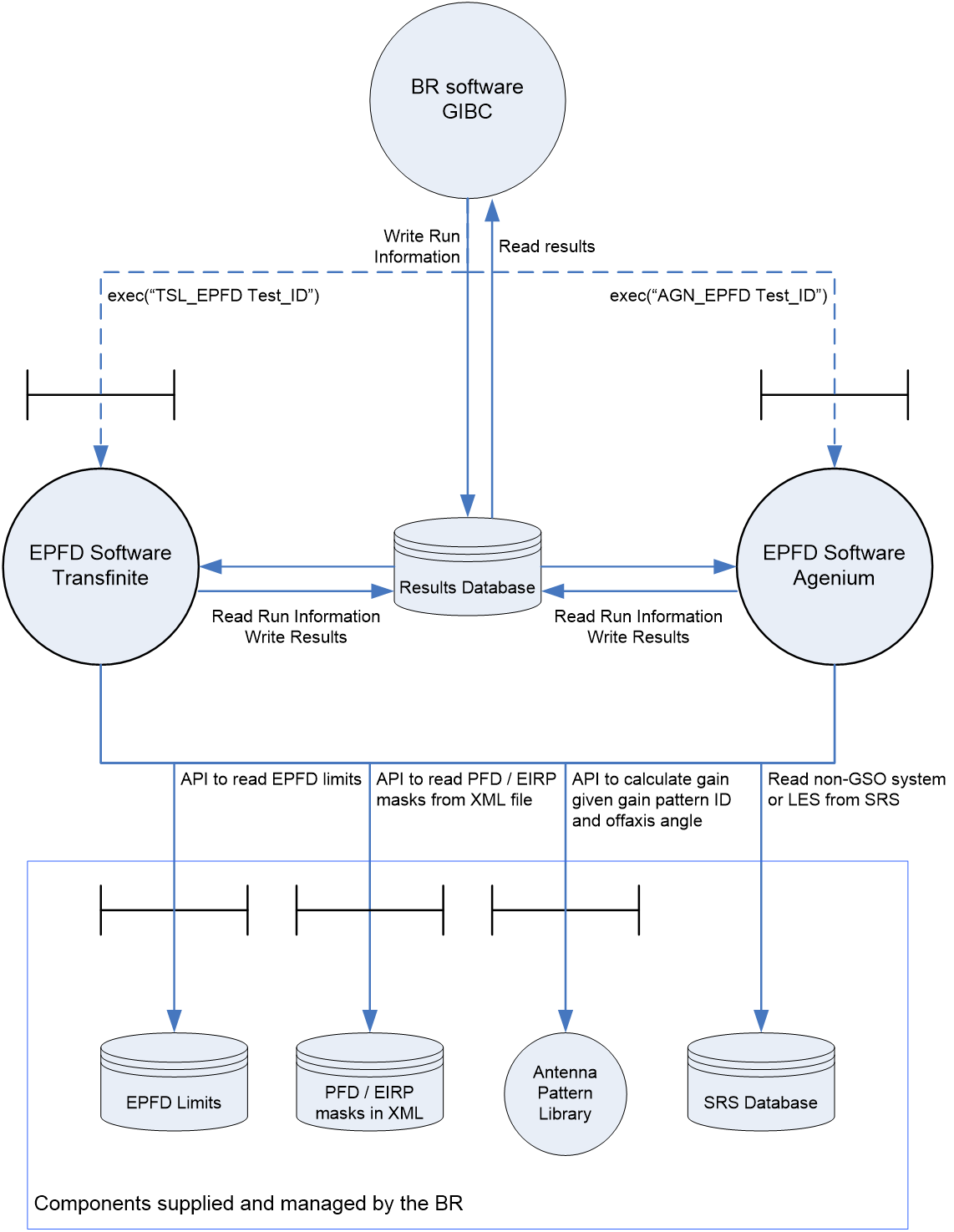Introduction
Article 22 of the Radio Regulations identifies Equivalent Power Flux Density (EPFD) levels to protect satellites in geostationary orbit (GSO) from unacceptable interference from non-GSO satellite systems.
EPFD is defined as follows:

Each of the terms is specified in 22.5C.1 of the Radio Regulations but essentially the equation specifies how to calculate a power flux density adjusted (hence the “equivalent”) to take into account the discrimination at the receiver antenna in the direction of the interferer.
As a non-GSO satellite moves in time the EPFD level calculated will vary and over time it will be possible to create a cumulative distribution function (CDF) of EPFD level against probability that the EPFD level is exceeded. These CDFs vary depending upon factors such as the gain pattern at the victim.
A non-GSO satellite system can cause interference into both a GSO satellite’s uplink and downlink, and there could be up to three directions to consider:
- EPFD (down): from the nonGSO satellites into a GSO Earth Station
- EPFD (up): from the nonGSO Earth stations into a GSO satellite
- EPFD (IS): inter-satellite (IS) path from the nonGSO satellites into a GSO satellite
The CDFs of EPFD for these three directions can then be compared against the limits in the tables referenced in 22.5C. These are generally described as hard limits in that if the non-GSO satellite system meets the values in these tables it is considered to have met its obligations under Article 22. The tables specify different thresholds depending upon whether the victim is operating under the fixed satellite service (FSS) or broadcasting satellite service (BSS)
The limits in Article 22 may be exceeded in any country whose administration has so agreed: however this is outside the scope of Visualyse EPFD.
Note that in some bands where there could be both GSO and non-GSO networks operating there are no EPFD limits specified in Article 22 and instead coordination is undertaken as described in Article 9.
In addition, Appendix 5 of the Radio Regulations (RR) identifies the triggers for coordination for the case of large earth stations (LES) for which:
- The earth station antenna gain is above 64 dBi for Ku band and 68 dBi for Ka band
- The earth station’s G/T is 44 dB/K or greater
- The emission bandwidth is 250 MHz or greater for Ku band or 800 MHz or greater in Ka band
If these criteria are met then there is a need for coordination under articles 9.7A and 9.7B of the RR with those non-GSO networks that are co-frequency.
The methodology to determine the EPFD levels generated by a non-GSO satellite system is documented in Recommendation ITU-R S.1503-2:
“Functional description to be used in developing software tools for determining conformity of non-geostationary-satellite orbit fixed-satellite system networks with limits contained in Article 22 of the Radio Regulations”
This methodology has been implemented in Visualyse EPFD. As the algorithm, and hence implementation, is complex, another version of the software was developed independently by Agenium and then compared under the aegis of the ITU. The differences between the results from each tool were below 0.1 dB in most cases.
Each tool interfaces to a range of ITU supplied databases, DLLs and data files as shown in the figure below.

In each case the output from the software is either a “pass” or “fail” depending upon whether the EPFD CDF calculated was below or above the threshold values given in the RR.
There are two versions of Visualyse EPFD:
- GIBC driven black box that provides a simple dialog to select the case to analyse and reports progress
- Graphical User Interface (GUI) version that provides feedback as to the run status and checks on intermediate values in the calculation
This User Guide covers the GUI version of Visualyse EPFD.
There are three types of analysis:
- Article 22 check: a non-GSO FSS network is selected from the SRS and checked against the hard limits in Article 22
- Article 9.7A check: a LES is selected from the SRS and run against those non-GSO FSS networks in the database that have bandwidth overlap in the relevant frequency bands
- Article 9.7B check: a non-GSO FSS network is selected from the SRS and run against those LES networks in the database that have bandwidth overlap in the relevant frequency bands
Note that a “fail” against the limits in Article 22 is sufficient for a non-favourable finding by the BR. On the other hand a “fail” in the case of a 9.7A or 9.7B check is the trigger for coordination between the operators involved and does not necessarily mean a non-favourable finding.
In each case the first step is to identify how many cases or “runs” must be analysed where a runs involves:
- One non-GSO network
- One victim (either GSO Earth Station or GSO satellite)
- One set of EPFD limits (e.g. for FSS service in 19.7 – 20.2 GHz with ES 2.5m)
For Article 9.7A and 9.7B the runs are always EPFD(down) cases and the locations of the ES are explicitly given in the SRS. For Article 22 runs the location of the victim ES or satellite are calculated using the “worst case geometry” (WCG) algorithm part of Rec. ITU-R S.1503-2.
Note that Article 22 also includes other types of EPFD, in particular “operational EPFD limits” and “additional operational EPFD limits”: these relate to measurement and are outside the scope of Visualyse EPFD.